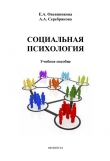
Текст книги "Социальное влияние"
Автор книги: Филип Зимбардо
Соавторы: Майкл Ляйппе
Жанр:
Психология
сообщить о нарушении
Текущая страница: 49 (всего у книги 51 страниц)
Feshbach, S. (1980). Television advertising and children: Policy issues and alternatives. Paper presented at the American Psychological Association convention.
Festinger, L. (1954). A theory of social comparison processes. Human Relations, 7, 117–140.
Festinger, L. (1957). A theory of cognitive dissonance. Stanford, CA: Stanford University Press.
Festinger, L., and Carlsmith, J. M. (1959). Cognitive consequences of forced compliance. Journal of Abnormal and Social Psychology, 58. 203–211.
Fincham, F'. D., Beach, S. R., and Baucom, D. H. (1987). Attribution processes in distressed and nondistressed couples: 4. Self – partner attribution differences. Journal of Personality and Social Psychology, 52, 739–748.
Fincham, F. D., and O'Leary, K. D. (1983). Causal inferences for spouse behavior in maritally distressed and nondistressed couples. Journal of Social and Clinical Psychology, 1, 42–57.
Fisher, J. D., Belt, P. A., and Baum, A.. (1984). Environmental psychology (2d ed.). New York: Holt, Rinehart & Winston.
Fiske, S. Т., Taylor, S. E. (1984). Social cognition. Reading, MA: Addison – Wesley.
Flay, B. R., Ryan, К. В., Best, J. A., Brown, K. S., Kersell, M. W., d'Avernas, J. R., and Zanna, M. P. (1985). Are social – psychological smoking prevention programs effective? The Waterloo study. Journal of Behavioral Medicine, 8 37–59.
Freedman, J. L., and Fraser,S.C. (1966). Compliance without pressure: The foot – in – the – door technique. Journal of Experimental Social Psychology, 4, 195–203.
Freedman, J. L., and Sears, D. O. (1965). Warning, distraction, and resistance to influence. Journal of Personality and Social Psychology, 1, 145–155.
Frey,D. (1986). Recent research on selective exposure to information. In L. Berkowitz (Ed.), Advances in experimental social psychology (vol. 19, pp. 41–80). New York: Academic Press.
Frey,D., and Rosch.M. (1984). Information seeking after decisions: The roles of novelty of information and decision reversibility. Personality and Social Psychology Bulletin, 10, 91–98.
Fuller, R. G. C., and Sheehy – Skeffington, A. (1974). Effects of group laughter on responses to humorous materials: A replication and extension. Psychological Reports, 35, 531–534.
Galanter, H. (1989). Cults: Faith, healing, and coercion. New York: Oxford University Press.
Getter, E.S., WitmerJ.F., and Tuso, M. A. (1977). Environmental interventions for litter control. Journal of Applied Psychology, 62, 344–351.
Giacalone, R., and Rosenfeld, P. (1986). Self – presentation and self – promotion in an organizational setting. Journal of Social Psychology, 126,321–326.
Gibbs, N. (1989). Sick and tired. Time, July 31, 48–53.
Gilligan, С (1982). In a different voice: Psychological theory and women's development. Cambridge, MA: Harvard University Press.
Goethals, G.R., and DarleyJ. (1977). Social comparison theory: An attributional perspective. In J. Suls and R. Miller (Eds.), Social comparison processes: Theoretical and empirical perspectives (pp. 259–278). Washington, DC: Hemisphere.
Goethals, G. R., and Ebling, T. (1975). A study of opinion comparison. Unpublished manuscript, Williams College.
Goethals, G. R., and Zanna, M. P. (1979). The role of social comparison in choice shifts, journal of Personality and Social Psychology, 37, 1469–1476.
Goleman, D. (May 29, 1990). As bias crime seems to rise, scientists study roots of racism. The New York Times, pp. B5, B7.
Gorn, G. J. (1982). The effects of music in adverti – singon choice behavior: A classical conditioning approach. Journal of Marketing, 46, 94–101.
Gouldner, A. W. (1960). The norm of reciprocity: A preliminary statement. American Sociological Review, 25, 161–178.
Granberg, D., and Brent, E. (1983). When prophecy bends: The preference – expectation link in U. S. presidential elections, 1952–1980. Journal of Personality and Social Psychology, 45,477–491.
Granberg, D., and Brent, E. E. (1974). Dove – hawk placements in the 1968 election: Application of social judgment and balance theories. Journal of Personality and Social Psychology, 29, 687–695.
Gray, F., Graubard, P. S., and Rosenberg, H. (1974). Little brother is changing you. Psychology Today, March, 42–46.
Greenwald, A. G, (1968). Cognitive learning, cognitive response to persuasion, and attitude change. In A. G. Greenwald, Т. С Brock, and Т. М. Ostrom (Eds.), Psychological foundations of attitudes (pp. 147–170). New York: Academic Press.
Greenwald, A. G. (1980). The totalitarian ego: Fabrication and revision of persona] history. American Psychologist, 35, 603–618.
Greenwald, A. G., Klinger, M. R., and Liu, T.J. (1989). Unconscious processing of dichoptically masked words. Memory & Cognition, 17, 35–47.
Grice, H. P. (1986). Logic in conversation. In I. P. Cole and J. L. Morgan (Eds.), Syntax and Semantics (vol. 3, pp. 41–58). New York: Academic Press.
Cruder, C. L., Cook, T.D., Hennigan, К. М., Flay, B. R.,Alessis, C, and Halamaj, J. (1978). Empirical tests of the absolute sleeper effect predicted from the discounting cue hypothesis. Journal of Personality and Social Psychology, 36, 1061–1074.
Grusec, J.E. (1971). Power and the internalization of self – denial. Child Development, 42, 93–105.
Grusec, J.E., and Skubiski.S. (1970). Model nurturance, demand characteristics of the modeling experiment and altruism. Journal of Personality and Social Psychology, 14, 353–359.
Crush, J. E. (1976). Attitude formation and mere exposure phenomena: A nonartifactual explanation of empirical findings. Journal of Personality and Social Psychology, 33, 281–290.
Crush, J. E., McKeough, K. L., and Ahlering, R. F. (1978). Extrapolating laboratory exposure
research to actual political elections. Journal of Personality and Social Psychology, 36, 257–270.
Hamilton, D. L., and Trolier, Т. К. (1986). Stereotypes and stereotyping: An overview of the cognitive approach. In J. F. Dovidio and S. L. Gaertner (Eds.), Prejudice, discrimination, and racism (pp. 127–164). New York: Academic Press.
Hardyck, J. A., and Kardush, M. (1968). A modest, modish model for dissonance reduction. In R. Abelson et al. (Eds.), Theories of cognitive consistency: A sourcebook. Chicago: Rand McNally.
Haritos – Fatouros, M.. (1988). The official torturer: A learning model for obedience to the authority of violence. Journal of Applied Social Psychology, 18, 1107–1120.
Harper, R. G., Weins, A. N., and Matarazzo, J. D. (1978). Nonverbal communications: The state of the art. New York: Wiley.
Harris, P. R. (1980). Promoting health – preventing disease: Objectives Tor the nation. Washington, DC: U.S. Government Printing Office.
Hass, R. G. (1981). Effects of source characteristics on cognitive responses and persuasion. In R. E. Petty, Т. М. Ostrom, and Т. С Brock (Eds.), Cognitive responses in persuasion (pp. 141–172). Hillsdale, NJ: Erlbaum.
Hass, R. G., and Grady, K. (1975). Temporal delay, type of forewarning, and resistance to influence. Journal of Experimental Social Psychology, 11, 459–469.
Hastie, R., Landsman, R., and Loftus, E. F. (1978). Eyewitness testimony: The dangers of guessing. Jurimetrics Journal, 19, 1–8.
Hayes, S. Cand Cone, J. D. (1977). Reducing residential electrical energy use: Payments, information, and feedback. Journal of Applied Behavior Analysis, 10,425–435.
Heesacker, M. (1986). Counseling pretreatment and the elaboration likelihood model of attitude change. Journal of Counseling Psychology, 33, 107–114.
Heider, F. (1958). The psychology of interpersonal relations. New York: Wiley.
Herbert. F. (1965). Dune. Philadelphia: Chilton.
Herek, G. M. (1986). The instrumentality of attitudes: Toward a neofunctional theory. Journal of Social Issues, 42, 99–114.
Hersey,J. (1988). Behind barbed wire. The New York Times Magazine, Sept., 57–59. 73–76, 120–121.
Hitler, A. (1933). Mein Kampf. Trans, by E. T. S. Dugdale. Cambridge, MA: Riverside.
Hochbaum, G. (1958). Public participation in medical screening programs. DHEW Publication No. 572, Public Health Service. Washington, DC: U.S. Government Printing Office.
Horowitz, 1. A. (1980). Juror selection: A comparison of two methods in several criminal cases. Journal of Applied Social Psychology, 10, 86–99.
Hosch, H. M., Leippe.M. R., Marchioni, P. M., and Cooper, D. S. (1984). Victimization, self – monitoring, and eyewitness identification. Journal of Applied Psychology, 64, 280–288.
Hovland, C. I. (Ed.) (1957). Order of presentation in persuasion. New Haven, CT: Yale University Press.
Hovland, C. I., and Janis, I. L. (1959). Personality and persuasibility. New Haven, CT: Yale University Press.
Hovland, С. I., Janis, I. L., and Kelley,H.H. (1953). Communication and persuasion. New Haven, CT: Yale University Press.
Hovland, C. I., Lumsdaine, A. A., and Sheffield, F. D. (1949). Studies in social psychology in World War II. Vol. 3: Experiments in mass communication. Princeton, NJ: Princeton University Press.
Hovland, С. /., and Mandell, W. (1952). An experimental demonstration of conclusion – drawing by the communicator and by the audience. Journal of Abnormal and Social Psychology, 47, 581–588.
Hovland, С I., and Weiss, W. (1951). The influence of source credibility on communication effectiveness. Public Opinion Quarterly, 15, 635–650.
Huesmann, L. R., Eron, L. D., Klein, R., Brice, P., and Fischer, P. (1983). Mitigatingthe imitation of aggressive behaviors by changing children's attitudes about media violence. Journal of Personality and Social Psychology, 44, 899–910.
Inbau, F. E., and Reid,J.E. (1962). Criminal interrogation and confessions. Baltimore: Williams and Wilkins.
Inbau, F.E., Reid.J.E., and Buckley, J. (1986). Criminal interrogation and confessions. Baltimore: Williams and Wilkins.
Insko, С A., Smith, R. H., Alicke, M. D., Wade, J., and Taylor, S. (1985). Conformity and group size: The concern with being right and the concern with being liked. Personality and Social Psychology Bulletin, 11, 41–50.
Iyengar, S., Kinder, D. R.. Peters, M. D., and Krosnick, J. A. (1984). The evening news and presidential evaluations. Journal of Personality and Social Psychology, 46, 778–787.
Janis, I. L. (1984). Improving adherence to medical recommendations: Prescriptive hypotheses derived from recent research in social psychology. In A. Baum, S. E. Taylor, and J. E. Singer (Eds.), Handbook of psychology and health (vol. 4, pp. 113–148). Hillsdale, NJ: Erlbaum.
Janis, I. L., and Field, P. B. (1956). A behavioral assessment of persuasibility: Consistency of individual differences. Sociometry, 19, 241–259.
Janis, 1. L., Kaye, D., and Kirschner, P. (1965). Facilitating effects of «eating – while – reading» on responsiveness to persuasive communications. Journal of Personality and Social Psychology, 1, 181–186.
Janis, I. L., and King, В. Т. (1954). The influence of role – playing on opinion change. Journal of Abnormal and Social Psychology, 49, 211–218.
Janis, I. L., and Mann, L. (1965). Effectiveness of emotional role – playing in modifying smoking habits and attitudes. Journal of Experimental Research in Personality, 1, 84–90.
Janis, I. L., and Mann, L, (1977). Decision making. New York: Free Press.
Johnson, В. Т., and Eagly.A. H. (1989). Effects of involvement on persuasion: A meta – analysis. Psychological Bulletin, 104, 290–314.
Johnson, H. H., and Watkins,T.A. (1971). The effects of message repetition on immediate and delayed attitude change. Psychonomic Science, 22, 101–103.
Johnson, M. K., and Raye,C.L. (1981). Reality monitoring. Psychological Review, 88, 67–85.
Jones, E. E., and Davis, К. Е. (1965). From acts to dispositions: The attribution process in person perception. In L. Berkowitz (Ed.), Advances in experimental social psychology (vol. 2). New York: Academic Press.
Jones, E.E., and Harris, V.A. (1967). The attribution of attitudes. Journal of Experimental Social Psychology, 3, 2–24.
Jones, E. E., Rock, L., Shaver, K. G., Goethals, G. R., and Ward, L. M. (1968). Pattern of performance and ability attribution: An unexpected primacy effect. Journal of Personality and Social Psychology, 10, 317–340.
Sudd, С M., Kenny, D. A., and Krosnick, J. A. (1983). Judging the positions of political candidates: Models of assimilation and contrast. Journal of Personality and Social Psychology, 44, 952–963.
Kahn, D. (1987). It's a great ad, but will it sell? Newsday, Mar. 29, 80, 77.
Kahneman, D. (1973). Attention and effort. Engle – wood Cliffs, NJ: Prentice – Hall.
Kahneman, D., and Tversky,A. (1979). Prospect theory: An analysis of decision under risk. Econometrica, 47, 263–291.
Kalfus, G. R., Ferrari, J. R., Arean, P., Balser, D., Cotronea, R., Franco, M., and Hill, W. (1987). An examination of the New York mandatory seat belt law on a university campus. Law and Human Behavior, 11, 63–67.
Kallgren, С A., and Wood, W. (1986). Access to attitude – relevant information in memory as a determinant of attitude – behavior consistency. Journal of Experimental Social Psychology, 22, 328–338.
Kalven, H., and Zeisel, H. (1966). The American jury. Boston: Little, Brown.
Kamenetsky, С. (1984). Children's literature in Hitler's Germany: The cultural policy of National Socialism. Athens, OH: Ohio University Press.
Kandel, D. В., Kessler, R. С and Marguties, R. L. (1978). Antecedents of adolescent initiation into stages of drug use: A developmental analysis. Journal of Youth and Adolescence, 7, 13–40.
Kantola, S. J., Syme, G. /., and Campbell, N. A. (1984). Cognitive dissonance and energy conservation. Journal of Applied Psychology, 69,416–421.
Kaplan, M.F., and Miller, С. E. (1987). Group decision making and normative versus informational influence: Effects of type of issue and assigned decision rule. Journal of Personality and Social Psychology, 53, 306–313.
Karabenick, S.A. (1983). Sex – relevance of context and influenceability, Sistrunk and McDavid revisited. Personality and Social Psychology Bulletin, 9, 243–252.
Kassin, S. M., and Wrightsman, L. S. (1980). Prior confessions and mock jury verdicts. Journal of Applied Social Psychology, 10, 133–146.
Kassin, S. M., and Wrightsman, L. S. (1981). Coerced confessions, judicial instruction, mock juror verdicts. Journal of Applied Social Psychology, 11,489–506.
Kassin, S. M., Reddy,M.E., and Tulloch, W. F. (1990). Juror interpretations of ambiguous evidence: The need for cognition, presentation order, and persuasion. Law and Human Behavior, 14, 43–55.
Kates, R. W. (1976). Experiencing the environment as hazard. In H. M. Proshansky, W. H. Ittelson, and L. G. Rivlin (Eds.), Environmental psychology: People and their physical settings (2d ed.). New York: Holt, Rinehart & Winston.
Katz, D. (1960). The functional approach to the study of attitudes. Public Opinion Quarterly, 24, 163–204.
Keeton, R. E. (1973). Trial tactics and methods (2d ed.). Boston: Little, Brown.
Kelley, H. H. (1967). Attribution theory in social psychology. In D. Levine (Ed.), Nebraska symposium on motivation (vol. 51). Lincoln: University of Nebraska Press.
Kelley, H.H. (1972). Causal schemata and the attribution process. In E. E. Jones, D. E. Kanou – se, H. H. Kelley, R. E. Nisbett, S. Valins, and B. Weiner (Eds.), Attribution: Perceiving the causes of behavior. Morristown, NJ: General Learning Press.
Kendall, P. С (1987). Cognitive processes and procedures in behavior therapy. In G. T. Wilson, С M. Franks, P. С Kendall, and J. P. Foreyt (Eds.), Review of behavior therapy, theory and practice (vol. 11). New York: Guil – ford.
Key,W.B. (1973). Subliminal seduction. Engle – wood Cliffs, NJ: Signet.
Kiesler, С. А. (1971). The psychology of commitment: Experiments linking behavior to belief. New York: Academic Press.
Kihlstrom, J. F. (1987). The cognitive unconscious. Science, 237, 1445–1452.
Kinder, D. R., and Sears, D. O. (1981). Prejudice and politics: Symbolic racism versus racial threats to the good life. Journal of Personality and Social Psychology, 40, 414–431.
King, В. Т., and Janis, I. L. (1956). Comparison of the effectiveness of improvised versus non – improvised role – playing in producing opinion change. Human Relations, 9, 177–186.
Kircher, J. C, Horowitz, S. It7., and Raskin, D. С (1988). Meta – analysis of mock crime studies of the control question polygraph technique. Law and Human Behavior, 12, 79–90.
Kleinhesselink, R. /?., and Edwards, R. E. (1975). Seeking and avoiding belief – discrepant information as a function of its perceived refutability. Journal of Personality and Social Psychology, 31,787–790.
Koehnken, G. (1985). Speech and deception of eyewitnesses: An information processing approach. In F. L. Denmark (Ed.), Social/ecological psychology and' the psychology of women (pp. 117–139). New York: Elsevier Science Publishers.
Krauss, R. M., Apple, W., Morency, N'., Wenzel, C, and Winton,W. (1981). Verbal, vocal, and visible factors in judgments of another's affect. Journal of Personality and Social Psychology, 40, 312–320.
Kraut, R. (1980). Humans as lie detectors: Some second thoughts. Journal of Communications, 30(4), 209–216.
Kraut, R. E., and Рое, D. (1980). Behavioral routes of person perception: The deception judgments of customs inspectors and laymen. Journal of Personality and Social Psychology, 39, 784–798.
Krosnick,]. A. (1988). The role of attitude importance in social evaluation: A study of policy preferences, presidential candidate evaluations, and voting behavior. Journal of Personality and Social Psychology, 55, 196–210.
Kruglanski,A. W., and Mayseless, O. (1987). Motivational effects in the social, comparison of opinions. Journal of Personality and Social Psychology, 53, 834–842.
Kunst – Wilson, W. R., and Zajonc, R. B. (1980). Affective discrimination of stimuli that cannot be recognized. Science, 207, 557–558.
Kyle,S.O.. and Falbo, T. (1985). Relationships between marital stress and attributional preferences for own and spouse behavior. Journal of Social and Clinical Psychology, 3, 339–351.
Landers, S. (1990). Sex, condom use up among teenage boys. АРА Monitor, Apr., 25.
Landy,D. (1972). The effects of an overheard audience's reaction and attractiveness on opinion change. Journal of Experimental Social Psychology, 8, 276–288.
Langer, E. (1989). Mindfulness. Reading, MA: Addison – Wesley.
Langer, E., and Abelson, R. P. (1974). A patient by any other name…: Clinical group differences in labelling bias. Journal of Consulting and Clinical Psychology, 42, 4–9.
Langer, E., Blank, A., and Chanowitz, B. (1978). The mindlessness of ostensibly thoughtful action: The role of «placebic» information in interpersonal interaction. Journal of Personality and Social Psychology, 36, 635–642.
Langer, £., and Piper, A. (1987). The prevention of mindlessness. Journal of Personality and Social Psychology, 53, 280–287.
Lanzetta, 1. Т., Sullivan, D. G., Masters, R. D., and McHugo, G. J. (1985). Viewers' emotional and cognitive responses to televised images of political leaders. In S. Kraus and R. M. Perloff (Eds.), Mass media and political thought: An information processing approach (pp. 85–115). Beverly Hills, CA: Sage.
Lee,M. Т., and Ofshe, R. (1981). The impact of behavioral style and status characteristics on social influence: A test of two competing theories. Social Psychology Quarterly, 44, 73–82.
Leippe, M. R. (1979). Message exposure duration and attitude change: An information processing analysis of persuasion. Unpublished doctoral dissertation, Ohio State University.
Leippe, M. R.(1980). Effects of integrative memorial and cognitive processes on the correspondence of eyewitness accuracy and confidence. Law and Human Behavior, 4, 261–274.
Leippe, M. R. (1983). Persuasion, cognitive responses, and message exposure duration: Evidence for thought reversal. Paper presented at the meeting of the Eastern Psychological Association.
Leippe, M. R., and Elkin, R. A. (1987). When motives clash: Issue involvement and response involvement as determinants of persuasion. Journal of Personality and Social Psychology, 52, 269–278.
Leippe, M. R., and Romanczyk.A. (1989). Reactions to child (versus adult) eyewitnesses: The influence of jurors' preconceptions and witness behavior. Law and Human Behavior, 13, 103–131.
Leippe, M. R., Romanczyk, A., and Manion, A. P. (1990). Eyewitness persuasion: How and how well do factfinders judge the accuracy of adults' and children's memory reports. Manuscript submitted for publication, Adelphi University.
Leippe, M.R., Wells, G.L., and Ostrom., T.M. (1978). Crime seriousness as a determinant ot
accuracy in eyewitness identification. Journal ol Applied Psychology, 63, 345–351.
Lepper,M.R., Greene, D., and Nisbett,R.E. (1973). Undermining children's intrinsic interest with extrinsic reward: A test of the overjustifica – tion hypothesis. Journal of Personality and Social Psychology, 28, 129–137.
Leventhal, H. (1970). Findings and theory in the study of fear communications. In L. Berkowitz (Ed.), Advances in experimental social psychology (vol. 5). New York: Academic Press.
Leventhal, H., Watts, J. C, and Pagano, F. (1967). Effects of fear and instructions on how to cope with danger. Journal of Personality and Social Psychology, 6, 313–321.
Lewisohn, P. M., Mischel, W., Chapline, W., and Barton, R. (1980). Social competence and depression: The role of illusory self – perceptions. Journal of Abnormal Psychology, 89, 203–212.
Liebert, R. M., and Spra[kin, J. (1988). The early window: Effects of television on children and youth (3d ed.). New York: Pergamon.
Lifton,R.K. (1969). Thought reform and the psychology of totalism. New York: Norton.
Lind, E.A. (1982). The psychology of courtroom procedure. In N. L. Kerr and R. M. Bray (Eds.), The psychology of the courtroom (pp. 13–38). New York: Academic Press.
Lind, E. A., Erickson, В., Conley, J. M., and O'Barr, W.M. (1978). Social attributions and conversational style in trial testimony. Journal of Personality and Social Psychology, 36, 1558–1567.
Lind, E. A., Thibault,]., and Walker, L. (1973). Discovery and presentation of evidence in adversary and nonadversary proceedings. Michigan Law Review, 71, 1129–1144.
Lindsay, R. С L., Wells, G. L., and Rumpel, C. (1981). Can people detect eyewitness identification accuracy within and between situations? Journal of Applied Psychology, 66, 79–89.
Loftus, E.F. (1979). Eyewitness testimony. Cambridge, MA: Harvard University Press.
Loftus, E. F. (1974). Reconstructing memory: The incredible witness. Psychology Today, Dec, 116–119.
Loftus, E. F. (1984). Eyewitnesses: Essential but unreliable. Psychology Today, Feb., 22–26.
Loftus, E. F., Miller, D. G., and Burns, H. J. (1978). Semantic integration of verbal information into a visual memory. Journal of Experimental Psychology: Human Learning and Memory, 4, 19–31.
London, H. (1973). Psychology of the persuader. Morristown, NJ: General Learning Press.
Lord, С G., Lepper, M. R., and Preston, E. (1984). Considering the opposite: A corrective strategy for social judgment. Journal of Personality and Social Psychology, 47, 1231–1243.
Lord, С. О., Ross.L., and Lepper, M.R. (1979). Biased assimilation and attitude polarization: The effects of prior theories on subsequently considered evidence. Journal of Personality and Social Psychology, 37, 2098–2109.
Luchlns,A. (1957). Primacy – recency in impression formation. In C. I. Hovland (Ed.), The order of presentation in persuasion. New Haven, CT: Yale University Press.
Luthans.F., Paul,R., and Baker, D. (1981). An experimental analysis of the impact of contingent reinforcement on salespersons' performance behavior. Journal of Applied Psychology, 66,314–323.
Lutz, W. (1989). No one died in Tiananmen Square. The New York Times, July 12, Al, A9.
Luus, C.A.E., and Wells, G. L. (1991). Eyewitness identification and the selection of distractors for lineups. Law and Human Behavior, in press.
Lydon, J. E., and Zanna, M. P. (1990). Commitment in the face of adversity: A value – affirmation approach. Journal of Personality and Social Psychology, 58, 1040–1047.
Maccoby, N., Farquhar, J. W., Wood, P. D., and Alexander, J. (1977). Reducing the risk of cardiovascular disease: Effects of a community – based campaign on knowledge and behavior. Journal of Community Health, 3, 100–114.
MacCoun, R. J., and Kerr, N. L. (1988). Asymmetric influence in mock jury deliberations: Jurors' bias toward leniency. Journal of Personality and Social Psychology, 54, 21–33.
Maddux, J. E., and Rogers, R. W. (1983). Protection motivation and self – efficacy: A revised theory of fear appeals and attitude change. Journal of Experimental Social Psychology, 19, 469–479.
Malpass, R. S., and Devine, P. G. (1981). Eyewitness identification: Lineup instructions and the absence of the offender. Journal of Applied Psychology, 66, 345–351.
Handler, C, and Nakamura, Y, (1987). Aspects of consciousness. Personality and Social Psychology Bulletin, 13,299–313.
Mann, L., and Janis, I. L. (1968). A follow – up study on the long – term effects of emotional role playing. Journal of Personality and Social Psychology, 8, 339–342.
Manstead, A. S. R., Proffitt, C, and Smart, J. L. (1983). Predicting and understanding mothers' infant – feeding intentions and behavior: Testing the theory of reasoned action. Journal of Personality and Social Psychology, 44, 657–671.
Marbury, С. Н. (1989). An excursus on the biblical and theological rhetoric of Martin Luther King. In D. J. Garrow (Ed.), Martin Luther King, Jr.: Civil rights leader, theologian, orator (vol. 3). New York: Carlson.
Marcel, A. J. (1983). Conscious and unconscious perception: Experiments on visual masking and word recognition. Cognitive Psychology, 15, 197–237.
Maslach, C, Santee, R. Т., and Wade, С (1987). Individuation, gender role, and dissent: Personality mediators of situational forces. Journal of Personality and Social Psychology, 53, 1088–1093.
Maslach, C, Stapp, I., and Santee, R. T. (1985). Individuation: Conceptual analysis and assessment. Journal of Personality and Social Psychology, 49, 729–738.
McAlister, A. (1981). Antismoking campaigns: Progress in developing effective communications. In R. E. Rice and W. J. Paisley (Eds.), Public communication campaigns (pp. 91–103). Beverly Hills, CA: Sage.
McArthur, L.A. (1972). The how and what of why: Some determinants and consequences of causal attribution. Journal of Personality and Social Psychology, 22, 171–193.
McCullough. J.L., and Ostrom, Т. М. (1974). Repetition of highly similar messages and attitude change. Journal of Applied Psychology, 59, 395–397.
McGuire, W. J. (1964). Inducing resistance to persuasion: Some contemporary approaches. In L. Berkowitz (Ed.), Advances in experimental social psychology (vol. 1). New York: Academic Press.
McGuire, W.J. (1968). Personality and attitude change: An information processing theory. In A. G. Greenwald, Т. С Brock, and Т. М. Ostrom (Eds.), Psychological foundations of attitudes (pp. 171–196). New York: Academic Press.
McGuire, W.J. (1985). Attitudes and attitude change. In G. Lindzey and E. Aronson (Eds.), Handbook of social psychology: Volume II (3d ed., pp. 233–346). New York: Random House.
McGuire, W. J., and Papageorgis, D. (1961). The relative efficacy of various types of prior belief – defense in producing immunity against persuasion. Journal of Abnormal and Social Psychology, 62, 327–337.
McHugo, G. J., Lanzetta, J. Т., Sullivan, D. G., Masters, R. D., and Englis.B.G. (1985). Emotional reactions to a political leader's expressive displays. Journal of Personality and Social Psychology, 49, 1513–1529.
McPherson, K. (1983). Opinion – related information seeking: Personal and situational variables. Personality and Social Psychology Bulletin, 9, 116–124.
Mehrabian,A. (1972). Nonverbal communication. Chicago: Aldine – Atherton.
Mehrabian, A. (1981). Silent messages: Implicit communication of emotions and attitudes (2d ed.). Belmont, CA: Wadsworth.
Mehrabian, A., and Williams, M. (1969). Nonverbal concomitants of perceived and intended persuasiveness. Journal of Personality and Social Psychology, 13, 37–58.
Meyer, A. J., Nash, J. D., McAlister, A. L., Macco – by, N., and Farquhar, J. W. (1980). Skills training in a cardiovascular health education campaign. Journal of Consulting and Clinical Psychology, 48, 129–142.
Meyerowitz, В. Е., and Chaiken, S. (1987). The effect of message framing on breast self examination attitudes, intentions, and behavior. Journal of Personality and Social Psychology, 52,500–510.
Milgram, S. (1963). Behavioral study of obedience. Journal of Abnormal and Social Psychology, 67, 371–378.
Milgram, S. (1965). Some conditions of obedience to authority. Human Relations, 18, 57–76.
Milgram, S. (1974). Obedience to authority. New York: Harper & Row.
Millar, M. G., and Tesser, A. (1986). Effects of affective and cognitive focus on the attitude – behavior relationship. Journal of Personality and Social Psychology, 51, 270–276.
Miller, A. G. (1986). The obedience experiments: A case study of controversy in the social sciences. New York: Praeger.
Miller, G. A. (1962). Psychology: The science of mental life. New York: Harper & Row.
Miller, K.D. (1986). Martin Luther King, Jr., borrows a revolution: Argument, audience, and implications of a secondhand universe. College English, 48, 249–265.
Miller, N.E. (1978). Biofeedback and visceral learning. Annual Review of Psychology, 29, 373–404.
Miller, N., and Campbell, D. T. (1959). Recency and primacy in persuasion as a function of the timing of speeches and measurement. Journal of Abnormal and Social Psychology, 59, 1–9.
Milter, N., Maruyama,G., Beaber,R.J., and Valone, K. (1976). Speed of speech and persuasion. Journal of Personality and Social Psychology, 34, 615–624.
Milmoe.S., Rosenthal, R., Blane,H.T., Cha – fetz,M.E., and Wolf, E. (1967). The doctor's voice: Predictor of successful referral of alcoholic patients. Journal of Abnormal Psychology, 72, 78–84.
Mitchell, H. E. (1979). Informational and affective determinants of juror decision making. Unpublished doctoral dissertation, Purdue University. Molko v. Holy Spirit Association, 179 Cal. 3d 450; Daily Journal D. A. R. 13197 (1988).








